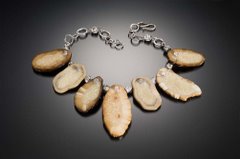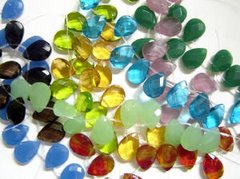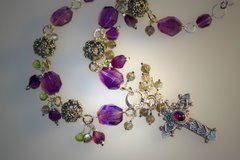
Design Sources
People visiting galleries, art shows or boutiques often wonder how designer handcrafted jewelry is created. They often ask, "Where do jewelry designs come from?" or "How does the artist design this jewelry?" In fact, many artists cannot tell you exactly where designs come from, but they can share how they go about designing jewelry. There are as many different approaches to creating designer handcrafted jewelry as there are artists working. Some artists have a predetermined style or a "branded look" with specific stone combinations or techniques that give a starting point for their designs. Other artists create commissioned pieces where the design marries the specific needs of the client with the specifics of an existing piece of jewelry. Perhaps the most challenging for artists is to start a design from scratch. Luckily, most artists will say that inspiration is all around them, all the time. They simply have to be aware of the visual resources around them every day. Whether it is the exquisite colors of tropical lizards, the wavy wrapping of a bird's nest, the mechanics of a doorbell or shaped and patterned seashells, the rhythm, color and patterns usually spark creativity and the beginning of new designs. Even when artists use similar design sources, that does not mean they will produce the same jewelry product. Two artists using a butterfly theme or motif as their inspiration will generate two quite different jewelry solutions. A butterfly theme may become a brooch encrusted with colorful, faceted gemstones or it may be created from fine silver, then hammered to create relief and patinated with chemicals to create a dark, rich metallic surface. That is why designer handcrafted jewelry is so intriguing.
Design Elements
Looking at the finished product, people often wonder how artists know if a piece has good design. How do artists decide what designs to use? Line, shape, color and texture are basics that most artists consider when designing jewelry. They also consider whether the piece has contrast, balance, symmetry/asymmetry, a focal point, and proportion. Sometimes the void or the space not filled up, called negative space, is the most important aspect of a design. Artists usually view the piece from many different angles, even upside down, to more easily analyze and isolate the different design strengths or weaknesses. Whether a piece conveys a feeling or mood or how well it functions is also considered at this design stage. Necklaces that are imbalanced, clasps that are uncomfortable on the neck, rings that are too thick between the fingers are issues that artists must resolve when designing. And of course, there are many different techniques and jewelry processes that can also determine the overall look and feel of jewelry. Forged metal may focus more on line and movement but not color. Texture can be created through hammering or milling. Relief can be created through repousse work or granulation. To create dynamic pieces of jewelry, the piece will have good flow and cause the eye to move all around it. To discover the best of many alternatives, designers have to explore or at least be aware of all the options open to them and then select those that will create the most interesting and beautiful piece.
Fingerprints
The best designer handcrafted jewelry is "fingerprinted"; that is, it bears the mark, the unique look and feel of the artist who created it. As jewelry designers focus their artistic techniques and hone their eye to visual themes, they will develop a completely individual style or "brand" that can often be identified by others. This is the goal toward which designers strive. Sometimes what begins as a mistake, a torch melts the edge of silver, or a patina goes darker than expected, can be a point of departure for an artist who wants to develop this branded look. That which was a "mistake" can become a new method of working with a particular media and then, in turn, become a distinguishing look of the artist's pieces. Todd Reed was one of the first to use unfaceted, rough diamonds in his work. Charles Lewton-Brain was one of the first to develop the techniques and unique look of fold-formed silver as a metalworking technique. Many well-respected jewelry artists today, who exhibit their work in fine galleries or sell their jewelry in fine craft shows, have one or two distinguishing elements to their work.
All designs of true jewelry artists are original, not just copied from something or someone else. By understanding and using the elements of design, the artists can purposefully change their original inspiration or starting point into a totally new creation. There are no real design "rules". Designer handcrafted jewelry is attractive and timeless because the artist who creates it has successfully used visual resources together with highly skilled techniques to create the one of a kind or limited edition pieces for which they are known.







